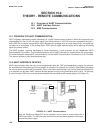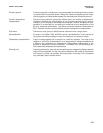
131
MODEL 3081 pH/ORP SECTION 16.0
GLOSSARY
Hold function During hold the Model 3081 pH/ORP transmitter generates a pre-programmed
output current or remains at the last value. Placing the transmitter in hold avoids
false alarms and unwanted operation of chemical dosing pumps while the sensor
is being calibrated or cleaned.
Intrinsically safe An enclosure is intrinsically safe if a spark or heat generated during normal oper-
ation or during a fault likely to occur in practice is incapable of igniting the gas,
vapor, or dust surrounding the enclosure.
Isopotential pH The isopotential pH is the pH at which voltage is independent of temperature. The
transmitter isopotential pH is 7.00. The isopotential pH of the measuring cell may
be different from 7.00. The greater the difference between the transmitter and cell
isopotential pH, the greater the error when the calibration and measurement tem-
peratures are different.
Isotherm A plot of cell voltage against pH is a straight line. The line is called an isotherm.
When temperature changes, the slope of the isotherm changes. Therefore, the
pH to which a given cell voltage corresponds depends on temperature. Meter
isotherms intersect at the meter isopotential point. Isotherms for pH measurement
cells rarely intersect at a single point, but they usually cross in a fairly small area.
Junction box Signal carrying wires are conveniently joined together in a junction box. Usually
the box contains two terminal strips connected internally point to point. The wires
in one cable are terminated on one strip, and the wires in the other cable are ter-
minated on the second strip. The point to point connection between the terminal
strips produces a point to point connection between the wires.
Liquid junction potential A liquid junction potential exists when two dissimilar electrolyte solutions come
into contact but are not allowed to mix. The potential arises from the different
mobilities of the ions in the contacting solutions. Generally the solution of great-
est concentration has the greatest influence on the size of the liquid junction
potential. Although liquid junction potentials cannot be eliminated, they can be
made small and relatively constant if the concentrated solution contains ions of
equal or nearly equal mobilities.
Measuring electrode A measuring electrode is an electrode for which the potential is proportional to the
concentration or activity of the substance of interest.
Menu A menu contains the steps that allows the user to calibrate or program the Model
3081pH/ORP transmitter or to read diagnostic messages.
Molar concentration Molar concentration is the number of moles of substance dissolved in one liter of
solution. A mole is a measure of the quantity of ions, molecules, or atoms in a sub-
stance.
Nernst equation The Nernst equation relates the potential of an electrode to the concentration or
activity of the chemical substances that appear in the half reaction occurring at
the electrode.
Non-incendive A non-incendive circuit is a circuit that is incapable of igniting a mixture of an
explosive gas in air under normal operating conditions. The gases used in the test
are the same gases used for intrinsically safe testing.
ORP ORP is oxidation-reduction potential. It is the tendency of a chemical species to
gain or lose electrons at a noble metal electrode. ORP is usually measured in mil-
livolts. The type of measuring electrode, the type of reference electrode and the
temperature must be identified when stating the ORP of a sample.
Oxidation Oxidation is the loss of electrons. For example, when an iron (II) ion becomes an
iron (III) ion, it is loses an electron: Fe
+2
= Fe
+3
+ e
-
.


















